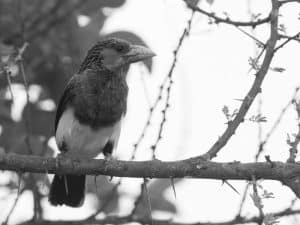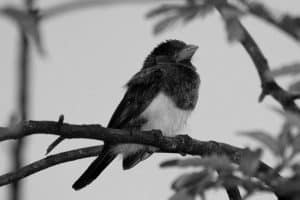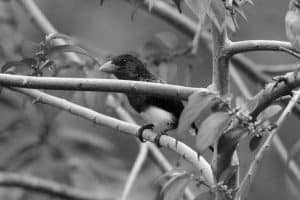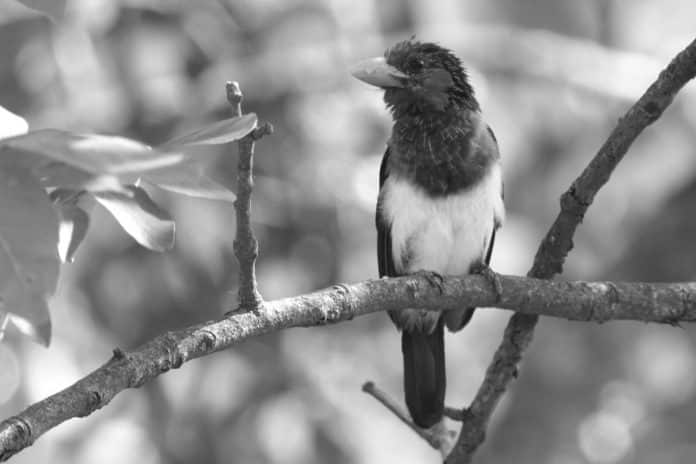Introduction to the Brown-Breasted Barbet
The brown-breasted barbet in Tanzania is a medium-sized bird that is easily recognizable by its distinctive plumage. It is a member of the barbet family, a group of birds that are known for their brightly colored feathers and distinctive beaks. The brown-breasted barbet is found throughout Tanzania, as well as in other parts of Africa, and it is a common sight in the country’s forests and woodlands.
Habitat and Behavior of the Brown-Breasted Barbet in Tanzania

The brown-breasted barbet is a tree-dwelling bird that is found in a variety of forested habitats, including montane forests, riverine forests, and savanna woodlands. It is a social bird that is often seen in pairs or small groups, and it is known for its distinctive call, which is a series of loud, raucous notes. The brown-breasted barbet feeds mainly on fruit and insects, and it is often seen perched high in the treetops, where it can easily spot its prey.
Identification and Physical Characteristics of the Brown-Breasted Barbet
The brown-breasted barbet is a medium-sized bird that measures between 20 and 24 centimeters in length. It has a distinctive plumage that is predominantly brown and green, with a bright red head and neck. It also has a distinctive white eye-ring and a large, curved bill that is used for cracking open tough fruits and nuts. The brown-breasted barbet is sexually dimorphic, with males having a brighter red head and neck than females.
Conservation Status and Threats to the Brown-Breasted Barbet
The brown-breasted barbet is classified as a species of least concern by the International Union for Conservation of Nature (IUCN). However, like many other bird species in Tanzania, it is threatened by habitat loss and fragmentation, as well as by hunting and trapping for the pet trade. In addition, climate change is expected to have a significant impact on the brown-breasted barbet’s habitat in the coming years.
Best Locations for Birdwatching the Brown-Breasted Barbet in Tanzania
The brown-breasted barbet can be found throughout Tanzania, but it is most commonly seen in the country’s forests and woodlands. Some of the best locations for birdwatching the brown-breasted barbet include the Usambara Mountains, the Eastern Arc Mountains, and the Selous Game Reserve. These areas offer a variety of different habitats, from montane forests to riverine forests, and they are home to a wide range of other bird species as well.
Tips for Spotting and Photographing the Brown-Breasted Barbet

Spotting and photographing the brown-breasted barbet can be a challenge, as these birds tend to be shy and elusive. However, there are a few tips and tricks that can help you increase your chances of success. One important tip is to listen for the bird’s distinctive call, which can help you locate it in the treetops. Another tip is to look for areas where the brown-breasted barbet is known to feed, such as fruiting trees or flowering shrubs.
Other Bird Species Commonly Found Alongside the Brown-Breasted Barbet in Tanzania
Tanzania is home to a wide range of bird species, and the brown-breasted barbet is often found alongside other colorful and exotic birds. Some of the other bird species commonly found alongside the brown-breasted barbet in Tanzania include the African green pigeon, the Schalow’s turaco, the white-eared barbet, and the yellow-throated tinkerbird.
Interesting Facts about the Brown-Breasted Barbet
The brown-breasted barbet is a fascinating bird with many interesting traits and behaviors. For example, it is known for its distinctive call, which sounds like a series of loud, raucous notes. It is also a social bird that is often seen in pairs or small groups. In addition, the brown-breasted barbet has a unique breeding strategy, in which both parents take turns incubating the eggs and caring for the young.
Conservation Efforts and Organizations Dedicated to Protecting the Brown-Breasted Barbet

There are a number of organizations dedicated to protecting the brown-breasted barbet and other bird species in Tanzania. One such organization is the Tanzania Bird Atlas, which works to map the distribution and abundance of bird species throughout the country. Another organization is the Nature Conservancy, which supports conservation efforts in the Eastern Arc Mountains, a key habitat for the brown-breasted barbet.
Conclusion: Appreciating the Beauty of the Brown-Breasted Barbet in Tanzania
The brown-breasted barbet is a beautiful and fascinating bird that is an important part of Tanzania’s natural heritage. By learning more about this species and supporting conservation efforts to protect it, we can help ensure that future generations will be able to appreciate its earthy tones in Tanzanian treetops.

































